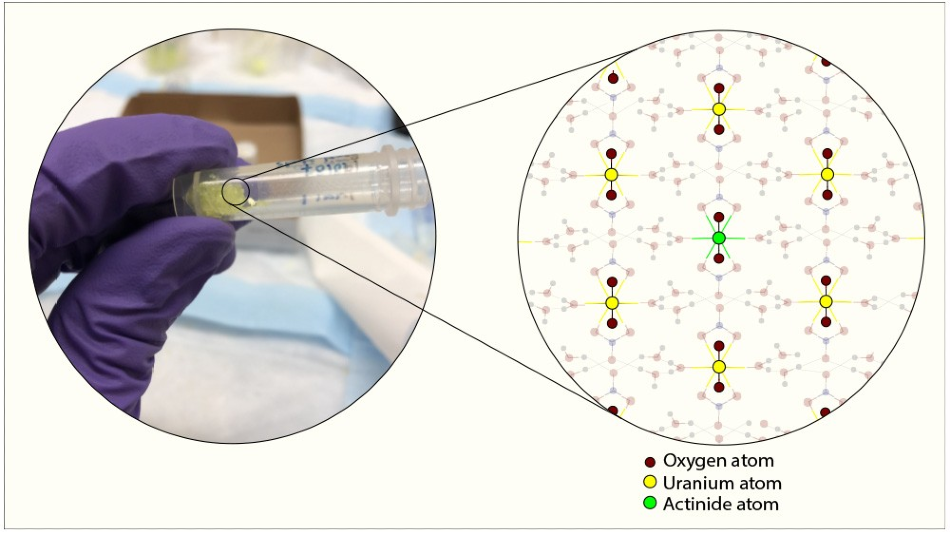May 5 2020
In a standard nuclear reactor, only a small fraction of the fuel rod is used to generate power before the energy-producing reaction ceases naturally. The remnant is a collection of radioactive elements, such as unused fuel, disposed of as nuclear waste in the United States.
 The one-step chemical reaction described in the study leads to the formation of crystals containing uranium (yellow-filled circles) and small quantities of other leftover fuel elements (green-filled circles). Image Credit: Jonathan Burns.
The one-step chemical reaction described in the study leads to the formation of crystals containing uranium (yellow-filled circles) and small quantities of other leftover fuel elements (green-filled circles). Image Credit: Jonathan Burns.
Some of the elements recycled from nuclear waste can be used for driving newer generations of nuclear reactors, but removing leftover fuel to prevent potential misuse is a constant challenge.
Engineering researchers at Texas A&M University have developed a simple, proliferation-resistant technique for isolating different constituents of nuclear waste. The one-step chemical reaction, which has been reported in the February issue of the Industrial & Engineering Chemistry Research journal, leads to the formation of crystals that contain all of the remnant nuclear fuel elements uniformly distributed.
In addition, the team observed that due to the simplicity of their recycling technique, the translation from lab bench to industry is viable.
Our recycling strategy can be easily integrated into a chemical flow sheet for industrial-scale implementation. In other words, the reaction can be repeated multiple times to maximize fuel recovery yield and further reduce radioactive nuclear waste.
Jonathan Burns, Research Scientist, Nuclear Engineering and Science Center, Engineering Experiment Station, Texas A&M University
In nuclear reactors, energy is produced based on thermonuclear fission—a reaction in which a heavy nucleus (uranium in general) is hit by subatomic particles known as neutrons. The nucleus turns unstable and disintegrates into smaller, lighter elements. But, in the course of the reaction, uranium may absorb neutrons and turn increasingly heavier to form elements such as plutonium, neptunium, and americium, before splitting again and releasing energy.
Eventually, the fission reactions result in the accumulation of lighter elements in the nuclear reactor. However, about half of these fission products are considered as neutron poisons—they also tend to absorb neutrons quite similar to used nuclear fuel, leaving behind fewer neutrons for the fission reaction, thereby stopping the energy generation.
Thus, used fuel rods include leftover uranium, fission products, and negligible quantities of neptunium, plutonium, and americium. At present, These items are collectively known as nuclear waste in the United States. Due to their high radioactivity, they are stowed away in underground repositories.
Nuclear waste is a two-pronged problem. First, almost 95% of the starting material of the fuel is left unused, and second, the waste we produce contains long-lived, radioactive elements. Neptunium and americium, for example, can persist and radiate for up to hundreds of thousands of years.
Jonathan Burns, Research Scientist, Nuclear Engineering and Science Center, Engineering Experiment Station, Texas A&M University
Although researchers have been somewhat successful in isolating plutonium, uranium, and neptunium, the methods used for this purpose have been highly complex and have not been so successful in isolating americium.
In addition, Burns noted that the U.S. Department of Energy stipulates the recycling method to be proliferation-resistant. In other words, plutonium that could potentially be used in weapons should never be isolated from other nuclear fuel elements in the recycling process.
To fulfill the unmet demands of recycling nuclear waste, the team sought a simple chemical reaction with the ability to isolate all the preferable used nuclear fuel chemical elements together.
An analysis of previous research works revealed that at room temperature, uranium forms crystals in strong nitric acid. Uranium atoms are arranged in an exclusive way inside these crystals—a central uranium atom packed between two oxygen atoms on either side shares six electrons with each oxygen atom.
Burns added, “We immediately realized that this crystal structure could be a way to separate out plutonium, neptunium and americium since all of these heavy elements belong to the same family as uranium.”
According to the researchers, neptunium, plutonium, and americium took a similar bonding structure with oxygen as uranium, these elements would combine themselves into the uranium crystal.
For the experiments, the researchers formulated a surrogate solution of plutonium, uranium, americium, and neptunium in highly concentrated nitric acid at 60–90 °C to simulate dissolving of a real fuel rod in the strong acid. When the solution reached room temperature, as expected, it was found that uranium, plutonium, neptunium, and americium isolated from the solution together and uniformly distributed themselves inside the crystals.
According to Burns, this simplified, single-step technique is also proliferation-resistant as plutonium is not separated but combined inside the uranium crystals.
“The idea is that the reprocessed fuel generated from our prescribed chemical reaction can be used in future generations of reactors, which would not only burn uranium like most present-day reactors but also other heavy elements such as neptunium, plutonium and americium,” Burns stated.
In addition to addressing the fuel recycling problem and reducing proliferation risk, our strategy will drastically reduce nuclear waste to just the fission products whose radioactivity is hundreds rather than hundreds of thousands of years.
Jonathan Burns, Research Scientist, Nuclear Engineering and Science Center, Engineering Experiment Station, Texas A&M University
Jeffrey D. Einkauf from the Texas A&M Engineering Experiment Station’s Center for Nuclear Security Science & Policy Initiatives also contributed to this study. This study is funded by the U.S. Department of Energy.
Journal Reference:
Einkauf, J D & Burns, J D (2020) Recovery of Oxidized Actinides, Np(VI), Pu(VI), and Am(VI), from Cocrystallized Uranyl Nitrate Hexahydrate: A Single Technology Approach to Used Nuclear Fuel Recycling. Industrial & Engineering Chemistry Research. doi.org/10.1021/acs.iecr.0c00381.